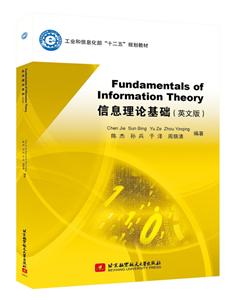信息理论基础-(英文版)
内容简介
[
Thisbooksystematicallyintroducedthefundamentalsofinformationtheory,focusingonthebasicmodelofcommunicationsystems.Itconsistsof11Chapters,includingtwoparts,namely,basicconceptionsofinforGmationtheoryandrelatedapplicationsofinformationtheory.Thefirstpartcontainsstatisticalmeasureofinformation,discretesource,losslesssourcecodinganddatacompression,discretechannelanditscapacity,channelcoding,whilethesecondpartincludesratedistortion,continuoussource,continuouschannelanditscapacity,maximumentropyandspectrumestimationaswellascomputersimulationexperimentsrelevanttoinformationtheory. Thisbooksummarizedtheexperienceoftheauthorsonteachinginformationcoursein EnglishandChinese,togetherwiththeirunderstandingsfromyearsscientificresearchpractice.Itcanbeusedasteachingmaterialoninformationtheorycourseforbothinternationalundergraduateandgraduatestudents.
]
目录
Chapter1 Introduction ………………………………………………………………………… 11.1 Conceptofinformation ………………………………………………………………… 11.2 Historyofinformationtheory ………………………………………………………… 21.3 Information,messagesandsignals …………………………………………………… 31.4 Communicationsystem model ………………………………………………………… 31.5 Informationtheoryapplications ……………………………………………………… 41.5.1 Electricalengineering(communicationtheory)………………………………… 41.5.2 Computerscience(algorithmiccomplexity) …………………………………… 5Exercises ……………………………………………………………………………………… 5Chapter2 StatisticalMeasureofInformation ………………………………………………… 62.1 Informationofrandomevents ………………………………………………………… 62.1.1 SelfGinformation …………………………………………………………………… 62.1.2 ConditionalselfGinformation ……………………………………………………… 62.1.3 Mutualinformationofevents …………………………………………………… 72.2 Informationofdiscreterandomvariables …………………………………………… 82.2.1 Entropyofdiscreterandomvariables …………………………………………… 82.2.2 Jointentropy……………………………………………………………………… 112.2.3 Conditionalentropy ……………………………………………………………… 112.2.4 Mutualinformationofdiscreterandomvariables …………………………… 112.3 Relationshipbetweenentropyandmutualinformation …………………………… 112.4 Mutualinformationandentropyofcontinuousrandomvariables………………… 122.4.1 Mutualinformationofcontinuousrandomvariables ………………………… 122.4.2 Entropyofcontinuousrandomvariables ……………………………………… 13Exercises ……………………………………………………………………………………… 14Chapter3 DiscreteSourceandItsEntropyRate …………………………………………… 153.1 Mathematicalmodelofsource ……………………………………………………… 153.1.1 Discretesourceandcontinuoussource ………………………………………… 163.1.2 Simplediscretesourceanditsextension ……………………………………… 173.1.3 Memorylesssourceandsourcewithmemory ………………………………… 183.2 Discretememorylesssource ………………………………………………………… 183.2.1 Definition ………………………………………………………………………… 183.2.2 Extensionofdiscretesource …………………………………………………… 193.3 Discretestationarysource …………………………………………………………… 203.3.1 Definition ………………………………………………………………………… 203.3.2 Entropyrateofdiscretestationarysource …………………………………… 213.4 DiscreteMarkovsource ……………………………………………………………… 243.4.1 Markovchain …………………………………………………………………… 243.4.2 Transitionprobability …………………………………………………………… 253.4.3 Markovsourceanditsentropyrate …………………………………………… 28Exercises ……………………………………………………………………………………… 31Chapter4 LosslessSourceCodingandDataCompression ………………………………… 334.1 Asymptoticequipartitionpropertyandtypicalsequences ………………………… 334.2 Losslesssourcecoding ……………………………………………………………… 344.2.1 Encoder …………………………………………………………………………… 344.2.2 Blockcode ………………………………………………………………………… 354.2.3 Fixedlengthcode………………………………………………………………… 364.2.4 Variablelengthcode …………………………………………………………… 424.3 Datacompression ……………………………………………………………………… 484.3.1 Shannoncoding ………………………………………………………………… 494.3.2 Huffmancoding ………………………………………………………………… 504.3.3 Fanocoding ……………………………………………………………………… 52Exercises ……………………………………………………………………………………… 52Chapter5 DiscreteChannelandItsCapacity ……………………………………………… 545.1 Mathematicalmodelofchannel ……………………………………………………… 545.2 Discretememorylesschannel ………………………………………………………… 555.2.1 Mathematicalmodelofdiscretememorylesschannel ………………………… 555.2.2 SimpleDMC ……………………………………………………………………… 565.2.3 Extensionofdiscretememorylesschannel …………………………………… 605.3 Channelcombination ………………………………………………………………… 655.4 Channelcapacity ……………………………………………………………………… 705.4.1 Conceptofchannelcapacity …………………………………………………… 705.4.2 Channelcapacityofseveralspecialdiscretechannels ………………………… 715.4.3 Channelcapacityofsymmetricchannels ……………………………………… 735.4.4 ChannelcapacityofextendedDMC …………………………………………… 755.4.5 ChannelcapacityofindependentparallelDMC ……………………………… 765.4.6 Channelcapacityofthesumchannel…………………………………………… 775.4.7 Channelcapacityofgeneraldiscretechannels ………………………………… 78Exercises ……………………………………………………………………………………… 79Chapter6 NoisyGchannelCoding ……………………………………………………………… 816.1 Probabilityoferror …………………………………………………………………… 816.2 Decodingrules ………………………………………………………………………… 836.3 Channelcoding ………………………………………………………………………… 846.3.1 Simplerepetitioncode …………………………………………………………… 846.3.2 Linearcode ……………………………………………………………………… 876.4 NoisyGchannelcodingtheorem ……………………………………………………… 91Exercises ……………………………………………………………………………………… 91Chapter7 RateDistortion …………………………………………………………………… 937.1 Quantization …………………………………………………………………………… 937.2 Distortiondefinition…………………………………………………………………… 947.2.1 Distortionfunction ……………………………………………………………… 947.2.2 MeanGdistortion ………………………………………………………………… 957.3 Ratedistortionfunction ……………………………………………………………… 977.3.1 Fidelitycriterionforgivenchannel …………………………………………… 977.3.2 Definitionofratedistortionfunction…………………………………………… 987.3.3 Propertyofratedistortionfunction …………………………………………… 987.4 Ratedistortiontheoremandtheconverse ………………………………………… 1017.5 Thecalculationofratedistortionfunction ………………………………………… 103Exercises …………………………………………………………………………………… 105Chapter8 ContinuousSourceandItsEntropyRate ……………………………………… 1078.1 Continuoussource …………………………………………………………………… 1078.2 Entropyofcontinuoussource ……………………………………………………… 1078.3 Maximumentropyofcontinuoussource…………………………………………… 1098.4 Jointentropy,conditionalentropyandmutualinformationforcontinuousrandomvariables …………………………………………………………………… 1098.5 Entropyrateofcontinuoussource ………………………………………………… 1118.6 Ratedistortionforcontinuoussource ……………………………………………… 114Exercises …………………………………………………………………………………… 117Chapter9 ContinuousChannelandItsCapacity …………………………………………… 1199.1 Capacityofcontinuouschannel …………………………………………………… 1199.1.1 CapacityofdiscreteGtimechannel……………………………………………… 1199.1.2 CapacityofcontinuousGtimechannel ………………………………………… 1209.2 TheGaussianchannel ……………………………………………………………… 1219.3 BandGlimitedchannels ……………………………………………………………… 1229.4 Codingtheoremforcontinuouschannel …………………………………………… 123Exercises …………………………………………………………………………………… 124Chapter10 MaximumEntropyandSpectrumEstimation ………………………………… 12510.1 Maximumentropyprobabilitydistribution ……………………………………… 12510.1.1 Maximumentropydistribution ……………………………………………… 12510.1.2 Examples ……………………………………………………………………… 12610.2 Maximumentropyspectrumestimation ………………………………………… 12710.2.1 Burgsmaxentropytheorem ………………………………………………… 12710.2.2 Maximumentropyspectrumestimation …………………………………… 130Exercises …………………………………………………………………………………… 137Chapter11 ExperimentsofInformationTheory …………………………………………… 13811.1 Measureofinformation …………………………………………………………… 13811.1.1 Informationcalculator ………………………………………………………… 13811.1.2 Propertiesofentropy ………………………………………………………… 13911.2 SimulationofMarkovsource ……………………………………………………… 14011.3 Performancesimulationforsourcecoding ……………………………………… 14111.3.1 Shannoncoding ……………………………………………………………… 14211.3.2 Huffmancoding ……………………………………………………………… 14311.3.3 Fanocoding …………………………………………………………………… 14411.4 SimulationofBSC ………………………………………………………………… 14411.5 Simulationofthecascadechannel ………………………………………………… 14511.6 Calculationofchannelcapacity …………………………………………………… 14811.7 Decodingrules ……………………………………………………………………… 14911.8 Performancedemonstrationofchannelcoding…………………………………… 150References ……………………………………………………………………………………… 152
封面

书名:信息理论基础-(英文版)
作者:陈杰
页数:153
定价:¥29.0
出版社:北京航空航天大学出版社
出版日期:2016-01-01
ISBN:9787512419728
PDF电子书大小:127MB 高清扫描完整版
